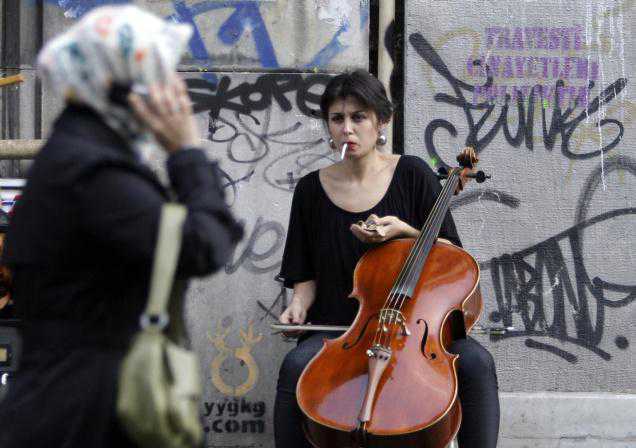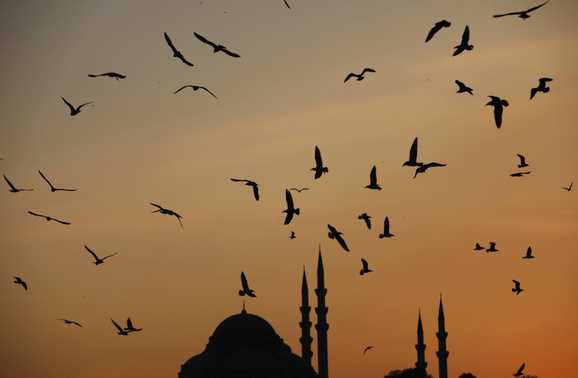Most of Istanbul’s Greeks may be gone, but a revival of the raucous, pre-Lent festival of Baklahorani helps keep their spirit alive.
Two parades, led by troupes of costumed revelers banging drums and blaring clarinets, wound through the streets of Istanbul on Sunday and Monday to celebrate Carnival before seven weeks of abstinence and reflection for the Orthodox faithful. Hundreds of Turks, Greeks and tourists donned masques and wigs to join the street parties.
This year was the biggest celebration yet of Baklahorani, which roughly translates as “eating beans” in reference to the Lenten fast, since its revival in 2010. It was a days-long Istanbul street festival for centuries until 1941, when Greeks, facing pressure from Turkish authorities, abandoned the festival.
“In the 70 years since Baklahorani, demonstrations of faith were done in private. Today it is a matter of pride to celebrate in public,” says organiser Haris Rigas, whose family left Istanbul for Greece decades ago. Rigas returned to Turkey five years ago to study political science at Istanbul’s Bogazici University.
About 800 people attended the first of the two parades that took place on Sunday and weaved through Istanbul’s main high street, Istiklal Caddesi in the district of Beyoglu. The same street witnessed a night of violence that targeted the city’s Greeks and other ethnic minorities in September 1955. Hundreds of people were injured, and more than 5,000 businesses were destroyed. That accelerated the decline of the Greek community in Istanbul, once the capital of the Byzantine Empire. Today, fewer than 3,000 Greeks, most of them pensioners, remain in their ancient homeland.
“I am here to celebrate Istanbul Greek culture,” said Burcu Karabiyik, 38, a sculptor wearing a red, sequined eye mask. “It’s important to stake a claim for Istanbul’s traditions and show solidarity when our society is so polarised.”
Most of Turkey’s Greeks were expelled after World War One in a population exchange that also brought Muslims here from Greece. In later years, tensions over Cyprus, social discrimination and restrictions on property and other rights forced out more than 150,000 others. Hundreds of millions of dollars worth of property has been appropriated, schools are left without pupils, and priests hold services in empty churches.
Istanbul, Europe’s largest city, is home to a mainly Muslim population of 14 million people, yet it retains the seat of the Ecumenical Patriarchate, the spiritual centre for the world’s 300 million Orthodox. About 60,000 Armenian Christians and 20,000 Jews also live here.
Turkey’s centre-right, Islamist-rooted government has made a few steps at improving the plight of Greeks since its election in 2002. They have granted Turkish citizenship to foreign bishops so they can join the Patriarchate’s Holy Synod, which runs the Church and provides candidates for future patriarchs. Other gestures have included permission for a Greek Orthodox mass at Sumela Monastery near the Black Sea town of Trabzon for the first time since the 1920s.
Progress on returning seized properties has been slow. Greeks, along with Israelis, are reportedly barred from buying homes in Beyoglu, which was populated by ethnic minorities during the Ottoman era. The Patriarchate’s seminary has been closed since 1971, making it impossible for the Church to train its clergy.
Despite the constraints they face, Baklahorani demonstrates that, at least on the street level, Greeks are more comfortable about expressing their identity. A second, smaller parade was held on Clean Monday in Kurtulus, the former Greek neighbourhood known as Tatavla that has traditionally been home to Baklahorani.
Istanbulites have in recent years begun celebrating the city’s native culture. The Sabanci Museum held a major exhibit last year featuring 5,000-year-old artefacts from the National Archaeological Museum in Athens, the first collaboration between Turkish and Greek museums. Nostalgia for Istanbul’s recent, cosmopolitan past has seen publication of cookbooks with Istanbul Greek recipes, rembetiko bands performing weekly in Beyoglu bars and Greek-style tavernas serving meze to boisterous crowds.
“By no means does Baklahorani represent a true revival of Greek community or culture,” Rigas says. “But it is still an expression of optimism for the Greek Orthodox of Turkey.”
via Simon Johns: Greek Carnival Revives the Spirit of an Ancient City.




